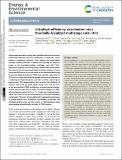| dc.contributor.author | Xu, Zhenyuan | |
| dc.contributor.author | Zhang, Lenan | |
| dc.contributor.author | Zhao, Lin | |
| dc.contributor.author | Li, Bangjun | |
| dc.contributor.author | Bhatia, Bikramjit S | |
| dc.contributor.author | Wang, Chenxi | |
| dc.contributor.author | Wilke, Kyle L. | |
| dc.contributor.author | Song, Youngsup | |
| dc.contributor.author | Labban, Omar | |
| dc.contributor.author | Lienhard, John H | |
| dc.contributor.author | Wang, Ruzhu | |
| dc.contributor.author | Wang, Evelyn | |
| dc.date.accessioned | 2020-02-12T16:13:30Z | |
| dc.date.available | 2020-02-12T16:13:30Z | |
| dc.date.issued | 2020-01 | |
| dc.date.submitted | 2019-12 | |
| dc.identifier.issn | 1754-5692 | |
| dc.identifier.issn | 1754-5706 | |
| dc.identifier.uri | https://hdl.handle.net/1721.1/123794 | |
| dc.description.abstract | Passive vapor generation systems with interfacial solar heat localization enable high-efficiency low-cost desalination. In particular, recent progress combining interfacial solar heating and vaporization enthalpy recycling through a capillary-fed multistage architecture, known as the thermally-localized multistage solar still (TMSS), significantly improves the performance of passive solar desalination. Yet, state-of-the-art experimental demonstrations of solar-to-vapor conversion efficiency are still limited since the dominant factors and the general design principle for TMSS were not well-understood. In this work, we show optimizing the overall heat and mass transport in a multistage configuration plays a key role for further improving the performance. This understanding also increases the flexibility of material choices for the TMSS design. Using a low-cost and free-of-salt accumulation TMSS architecture, we experimentally demonstrated a record-high solar-to-vapor conversion efficiency of 385% with a production rate of 5.78 L m−2 h−1 under one-sun illumination, where more than 75% of the total production was collected through condensation. This work not only significantly improves the performance of existing passive solar desalination technologies for portable and affordable drinking water, but also provides a comprehensive physical understanding and optimization principle for TMSS systems. | en_US |
| dc.publisher | Royal Society of Chemistry (RSC) | en_US |
| dc.relation.isversionof | http://dx.doi.org/10.1039/c9ee04122b | en_US |
| dc.rights | Creative Commons Attribution Noncommercial 3.0 unported license | en_US |
| dc.rights.uri | https://creativecommons.org/licenses/by-nc/3.0/ | en_US |
| dc.source | Royal Society of Chemistry (RSC) | en_US |
| dc.title | Ultrahigh-efficiency desalination via a thermally-localized multistage solar still | en_US |
| dc.type | Article | en_US |
| dc.identifier.citation | Xu, Zhenyuan et al. "Ultrahigh-efficiency desalination via a thermally-localized multistage solar still." Energy & Environmental Science 13, 1 (January 2020): c9ee04122b © 2020 Royal Society of Chemistry | en_US |
| dc.contributor.department | Massachusetts Institute of Technology. Department of Mechanical Engineering | en_US |
| dc.contributor.department | Massachusetts Institute of Technology. Department of Chemical Engineering | en_US |
| dc.relation.journal | Energy & Environmental Science | en_US |
| dc.eprint.version | Final published version | en_US |
| dc.type.uri | http://purl.org/eprint/type/JournalArticle | en_US |
| eprint.status | http://purl.org/eprint/status/PeerReviewed | en_US |
| dspace.date.submission | 2020-02-11T16:30:31Z | |
| mit.journal.volume | 13 | en_US |
| mit.journal.issue | 1 | en_US |
| mit.license | PUBLISHER_CC | |
| mit.metadata.status | Complete | |
